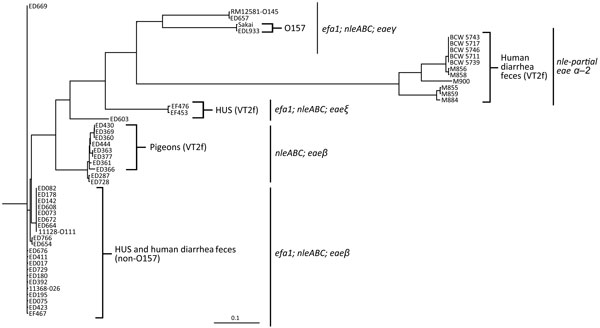Volume 22, Number 12—December 2016
Research
Whole-Genome Characterization and Strain Comparison of VT2f-Producing Escherichia coli Causing Hemolytic Uremic Syndrome
Figure 2

Figure 2. Parsimony tree obtained from the core-genome single-nucleotide polymorphism analysis of VT2f-producing verotoxigenic Escherichia coli (VTEC) strains from this study compared with VTEC belonging to the most relevant serogroups with publicly available sequences. In detail: 2 VTEC O157:H7 strains, EDL933 and Sakai (GenBank accession nos. NZ_CP008957.1 and NC_002695.1); 1 O26:H6, strain 11368 (accession no. NC_013361.1); 1 O145:H28, strain RM12581 (accession no. NZ_CP007136.1); and 1 O111:H-, strain 11128 (accession no. NC_013364.1). Scale bar indicates nucleotide substitutions per site.
Page created: November 17, 2016
Page updated: November 17, 2016
Page reviewed: November 17, 2016
The conclusions, findings, and opinions expressed by authors contributing to this journal do not necessarily reflect the official position of the U.S. Department of Health and Human Services, the Public Health Service, the Centers for Disease Control and Prevention, or the authors' affiliated institutions. Use of trade names is for identification only and does not imply endorsement by any of the groups named above.